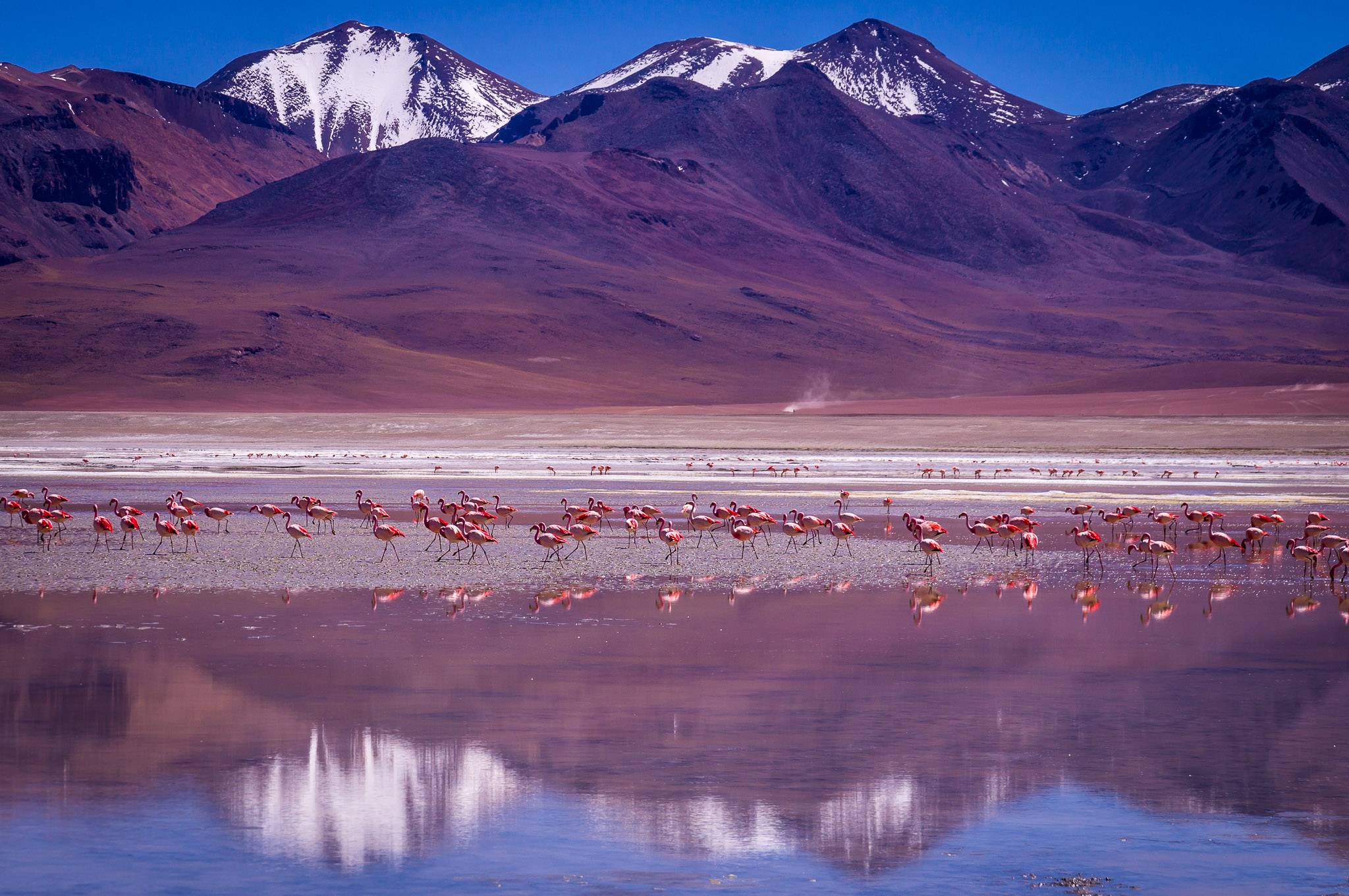Bolivia Travel Guide
Quick Facts
 Currency Currency | Boliviano (Bs) |
 Exchange Rate Exchange Rate | US$1 = Bs6.92 |
 Languages Languages | Spanish, Quechua, Aymara |
 English Fluency English Fluency | Moderate |
 Capital Capital | Sucre |
 Population Population | 11.67 million |
 Driving Side Driving Side | right |
 Plugs Plugs | A, C, I |
 Time Time | Bolivia Time (UTC-4) |
 Must-Try Must-Try | Salteñas, Silpancho, Sajta |
Backpacker Budget: US$21 (Bs 145)
| Hostel Dorm | US$10 (Bs 69) |
| Takeaway Meal | US$2 (Bs 14) |
| Public transport | US$1 (Bs 7) |
| Long-distance bus | US$7 (Bs 48) |
| Entrance Fee | US$5 (Bs 35) |
| Beer | US$2 (Bs 14) |
When to go?
| January - February | Low season - Warm and rainy |
| March - April | High season - Warm and dry |
| May - September | High season - Cool and dry |
| October - November | Low season - Warm and rainy |
| December | Low season - Hot and rainy |
What's unique?
Welcome to Bolivia, a country that will captivate you with its stunning landscapes, rich indigenous culture, and vibrant traditions. Nestled in the heart of South America, Bolivia offers a truly unique travel experience.
One of the highlights of Bolivia is its extraordinary natural beauty. From the otherworldly salt flats of Salar de Uyuni to the breathtaking heights of the Andes Mountains, this country boasts some of the most awe-inspiring landscapes on Earth. Explore the vast Amazon rainforest, where you can embark on thrilling wildlife encounters and immerse yourself in untouched nature.
But Bolivia isn't just about its natural wonders. It is also home to a fascinating blend of indigenous cultures that have preserved their traditions for centuries. Visit La Paz, one of the world's highest capital cities, where ancient customs coexist with modern city life. Discover colorful markets filled with traditional textiles and handcrafted goods, or witness traditional festivals that showcase vibrant costumes and mesmerizing dances.
Whether you're an adventure seeker looking for adrenaline-pumping activities like hiking or mountain biking, or a culture enthusiast eager to delve into Bolivia's rich heritage, this diverse country has something for everyone.
Bolivia Explorer (4 weeks)
- 1
Sucre
Sucre, the constitutional capital of Bolivia, is known for its well-preserved colonial architecture. Visit the historic city center, explore the museums, and enjoy the local cuisine.
- 2
Potosi
Potosi is a colonial city with a rich mining history. Take a tour of the Cerro Rico silver mine and learn about the hardships faced by the miners. Visit the Casa Nacional de la Moneda and explore the historic city center.
- 3
Uyuni
Uyuni is famous for its salt flats, the largest in the world. Take a jeep tour of the Salar de Uyuni and marvel at the stunning landscapes. Visit the Train Cemetery and enjoy the unique experience of staying in a salt hotel.
- 4
Cochabamba
Cochabamba is known as the gastronomic capital of Bolivia. Try traditional dishes like salteñas and pique a lo macho. Visit the Cristo de la Concordia, one of the largest statues of Jesus in the world, and enjoy the pleasant climate of the city.
- 5
Torotoro National Park
Torotoro National Park is a natural wonderland with stunning landscapes and dinosaur footprints. Explore the caves, hike to the waterfalls, and go on a guided tour to see the dinosaur tracks.
- 6
Villa Tunari
Villa Tunari, the door to the Amazon, is a great place for outdoor activities and adventure. Go hiking in the Carrasco National Park, go rafting and go on huge swings at La Jungla.
- 7
La Paz
La Paz, the administrative capital of Bolivia, is known for its dramatic setting and vibrant culture. Visit the Witches' Market, ride the cable car to enjoy panoramic views, and explore the historic city center.
- 8
Lake Titikaka
Lake Titikaka is the highest navigable lake in the world and home to indigenous communities. Take a boat tour to the floating islands of Uros, visit the traditional village of Taquile, and learn about the local culture and traditions.
Best Experiences
Fun Fact
Bolivia has the highest capital city in the world. La Paz sits at an altitude of 3,650 meters (11,975 feet) above sea level.
FAQ
Is Bolivia a safe country for tourists?
Bolivia is generally safe for tourists, but it is recommended to take precautions, especially in crowded areas and at night. It is also advisable to be aware of your surroundings and avoid displaying valuable items.
What are the top tourist destinations in Bolivia?
Some of the top tourist destinations in Bolivia include the Uyuni Salt Flats, Lake Titicaca, Sucre, La Paz, and the Amazon Rainforest.
What are some essential phrases in the local language?
Some essential phrases in Spanish, the main language spoken in Bolivia, include: - Hello: Hola - Thank you: Gracias - Excuse me: Perdón - Where is the bathroom?: ¿Dónde está el baño?
Travel Tips
- Money Card payment is often possible, but not always
- ATM Fees Most ATMs charge no fees
- Free ATMs Banco Ganadero, Banco Economico, Banco Bisa
- ATMs to avoid (high fees) Banco Union, BCP, BNB
- Do try the local cuisine, such as salteñas and silpancho.
- Do respect the local customs and traditions, including traditional dress and celebrations.
- Do ask for permission before taking photos of local people.
- Do be cautious with your belongings and avoid displaying expensive items.
- Don't drink tap water, opt for bottled water instead.
- Don't take coca leaves out of Bolivia, as it is illegal in most countries.
- Don't be surprised by the lack of punctuality, as Bolivian time can be more flexible.
